For a game about exploring the unknown, Horizon Forbidden West sure plays it safe.
Horizon Forbidden West follows directly in the path etched by its predecessor, 2017’s Horizon Zero Dawn. It’s an open-world role-playing game set a thousand years from now, in a version of America covered in rust, rubble, and robot dinosaurs. On your adventures, you clear dozens of bandit outposts, open hundreds of treasure chests, craft yourself an armory of battle-ready gear, and assist various folks who need assistance in various ways. You do all this as a young woman named Aloy (voiced by Ashly Burch), whose impeccable archery skills form the foundation of the action. You’ve done this all before.
Make no mistake: Despite its comfortably familiar trappings, Horizon Forbidden West is a tour de force. Its sprawling world feels alive with a tangible vigour many open-world games can only dream of. Not since The Witcher 3: Wild Hunt have I played side-quests as invariably engrossing as these. In moments of downtime, Forbidden West features a fully optional tactical mini-game that’s so captivating I almost had to ask for an extension on this review because I kept getting side-tracked (we’ll get to that). In the busier moments, the core offerings — running, jumping, climbing, gawking slack-jawed at giant robot dinosaurs, then shooting those robot dinosaurs with an inventive arsenal of bows and arrows — are a blast from tip to tail.
It’s a technological marvel to boot, too. In every frame, Horizon Forbidden West is a delectable feast for the eyes, at least on PlayStation 5, unseating last year’s Xbox racer Forza Horizon 5 as the best-looking console game in the neverending arms race of graphical fidelity. Pre-release coverage restrictions (Sony provided Kotaku with a PS5 copy of Horizon Forbidden West under condition of embargo) limit us to publishing 20 screenshots before launch. I’ll be frank, a small part of me wanted to just publish a post headlined “Here Are 20 Screenshots Of Horizon Forbidden West” and call it a day. This game is that beautiful — and, yes, for all you digital photogs, there’s a robust photo mode you can avail yourself of at any moment.
But it’s hard not to feel a twinge of disillusionment amid the splendor, much like the diminishing thrills you get when vacationing in the same place for a return trip. Horizon Zero Dawn was a revelation. Horizon Forbidden West is a refinement.
Horizon Forbidden West picks up several months after the events of Zero Dawn. Turns out, the big bad of that game — a malevolent artificial intelligence program known as HADES — wasn’t quite as defeated as Aloy was led to believe, but was exactly as undefeated as players were led to believe via Zero Dawn’s post-credits stinger. Also: the world is probably gonna end as a result. On word from her kinda-friend-kinda-not Sylens (Lance Reddick, who delivers all of his lines…like so), the solution to Aloy’s dilemma lies westward, past the confines of the charted world. So that’s where she goes.
Key to this western realm, and to Forbidden West’s multi-plotline story, is a factionalized nation known as the Tenakth. The Tenakth maintain a tenuous peace with the principalities of the first game: the Carja, the Oseram, and so on. But their leader, Hekarro, is grappling with a rebellion spearheaded by his former lieutenant, Regalla (the inimitable Angela Bassett), which threatens that peace.
Following her heroics in Zero Dawn, Aloy has attained a sort of messiah-like status, which allows her to do pretty much whatever she wants and go pretty much wherever she wants to go. People treat her with reverent awe and acquiesce to her requests, praising her as the “saviour.” One major city centres a prominent district around a statue of Aloy carved from gold. (“The sculptor wanted to go even bigger,” one character remarks.) But Aloy doesn’t have the time nor the patience for any of that. She just wants to save the world.
Alas, there is one place Aloy can’t just wander into unfettered: the west. You see, the west is, as the game’s title so aptly describes, forbidden (oh-ho!). The Tenakth keep a tight border; the only way Aloy is allowed to travel their lands is by attending a summit between east and west. Her first real task, simply, is to ensure the summit goes off without a hitch.
Throughout Forbidden West, characters comment on Aloy’s seemingly divine prowess. Little do they know, her “second sight” abilities are a result of how, as a child, she happened to find a wearable device from the old world called a Focus, which renders augmented reality overlays on the world, revealing a cascade of unseen information in neon light. In the early moments of Forbidden West, Aloy clues other characters into the verboten knowledge of the Focus, even providing versions of the device to her friends.
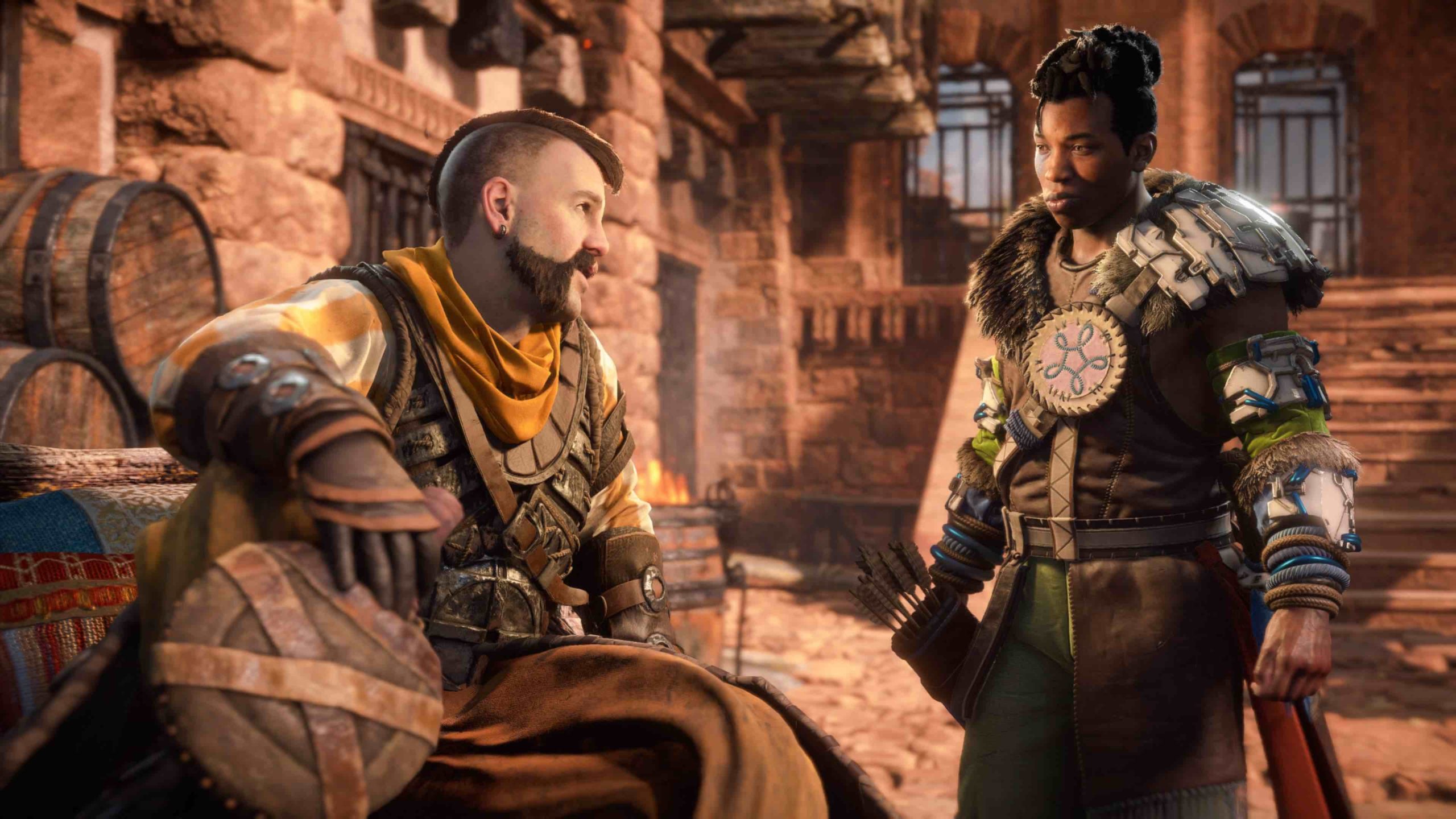
Sequels to open-world games tend to lean on a trope: They typically kick off with some disaster or other narrative mishap stripping the main character of all the powers and gear you painstakingly earned in the first game. That’s not the case for Horizon Forbidden West’s Aloy, who maintains much of her prowess, right down to certain skills — like the ability to slow down time while aiming her bow — being available from the start.
This allows Horizon Forbidden West a unique opportunity. Instead of some contrite sequence in which, for your benefit, she “learns” how to control a device she’s had years to master, Aloy walks her longtime friend Varl (John Macmillan) — and thus the player — through its quirks and functions. It’s a neat spin on the tired “you lost all your stuff” formula and forced tutorials that don’t make any narrative sense, for sure. But it’s nothing quite as groundbreaking as the highwater marks of its forebear.
It is perhaps unfair to measure Horizon Forbidden West against the lofty expectations established by Zero Dawn. Let’s rewind for a second to the 2010s, a not-exactly-halcyon era that saw the big studios of the world caught up in a cycle of sequels and threequels and prequels. Here we had a brand-new series from a studio (Guerrilla Games) best known — and perhaps written off by some — for a quintessentially generic series of sci-fi shooters known as Killzone. But this new game…man, it wasn’t just good. With its distinct action and unforgettable enemies, it was phenomenal, setting a standard for what an ambitious big-budget video game could accomplish. How fun! How fresh! How pleasantly unexpected.
From the jump, Horizon Forbidden West could never pull off the same hat trick. Its biggest gimmick — that it uses fossilized behemoths from the Mesozoic as blueprints for artificially intelligent war machines — isn’t a novelty that can be replicated. You know how it goes: You see one robot T. Rex, you’ve seen ‘em all.
To compensate for a lack of what experts call “holy shit!”-ness, Horizon Forbidden West distracts by throwing more at you — more giant robot dinosaurs, more Hollywood A-listers, more lens flare, more skill trees and upgrade materials and weapon variations and categories of optional activities, more, more, more, more, more.
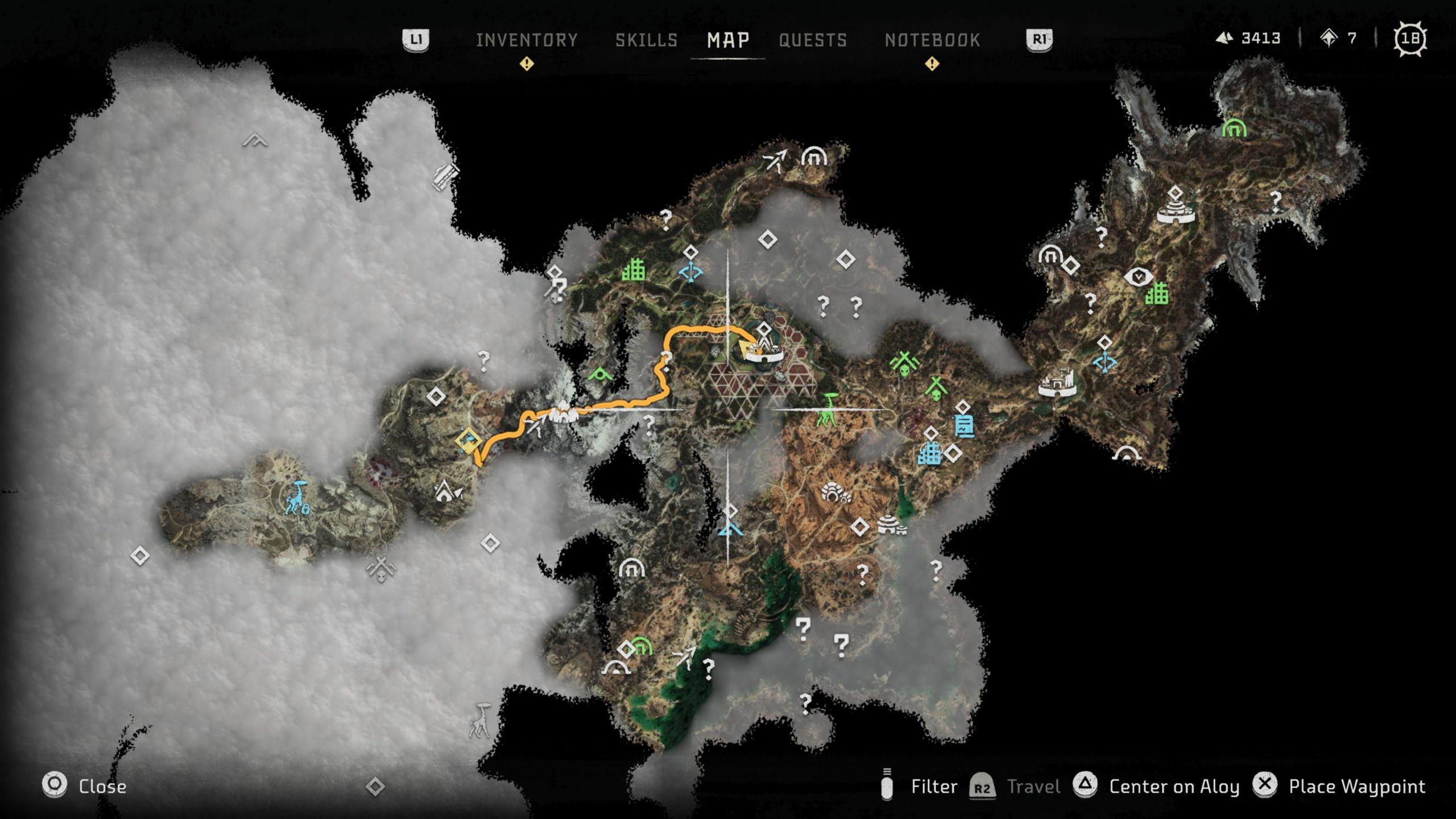
Fundamental systems that worked, like Zero Dawn’s peerless bow-shooting and unique approach to clearing a massive map’s fog of war (you climb a robot brachiosaurus), have been expanded. A slew of imaginative new weapons — explosive javelins, rapid-fire bows — join reimagined versions of the classics. Where “ropecaster” bows were once strictly used to tie down finicky enemies, now you can also use them to attach explosive canisters to machines. Where “tripcaster” bows were once strictly used to place traps on the battlefield, now you can also use them to generate handy shield walls.
The systems that didn’t work have been overhauled to the extent that they now do. Take, for instance, Zero Dawn’s climbing “puzzles,” which seemed like nothing more than a taped-on afterthought in 2017. Now, in part thanks to a nifty grappling hook and a straight-out-of-BotW hang glider, scaling cliffs and crumbled buildings is consistently engaging. (The obvious lesson: Put grappling hooks and hang gliders in every game.) Routes sprawl outward in branching, often head-scratching mazes. Whatever mechanical tweaks Guerrilla adjusted under the hood, you always feel in full control of where Aloy moves her limbs, too. The result is a recurrent mechanic akin to something out of Naughty Dog’s hit series of Uncharted adventure games — right down to that studio’s infamous “Hey this handhold seems like it’ll ho- ohhhh crap!” feature. What a welcome improvement.
If this all sounds like I’m preoccupied with considering Forbidden West in the incandescent light of its predecessor, well, that’s because the game itself openly invites such comparison. It’s almost imperative that you play the first one (or at least read through a fan wiki from cover to cover). A “previously on” narration calls out key plot points yet doesn’t elucidate the emotional anchors that steady those points. Characters mention past events devoid of any contextual framing. And while this all contributes to a natural conversational cadence in cutscenes, to the sense that you’re stepping into a world as real as ours — one in which people talk like people rather than characters who have to awkwardly shoehorn exposition into their interactions — it can get confusing at times. Indeed, despite having played Zero Dawn twice, I had to refer to one of those fan wikis several times throughout my 50-odd hours with Forbidden West, just to understand WTF people were talking about.
What’s more, Horizon Forbidden West doesn’t entirely wash itself of the sins of its past. In 2017, around the release of Zero Dawn, critic Dia Lacina pointed out how the game mishandled indigenous culture in a barnburner essay for Mic (originally published on Medium). Specifically, Lacina called out how Zero Dawn flagrantly tossed around phrases like “braves” and “savages” without including any deeper examination of said phrases, nor the historical weight behind them. The ensuing conversation spurred a response from Guerrilla; narrative director John Gonzalez told Vice the studio was “not intentionally being insensitive, or [meaning] to offend in any manner.”
I don’t for a second profess to speak for people of indigenous descent, though I will note that I certainly ran into some eyebrow-raising moments over the course of Forbidden West.
To be clear, I never heard the words “braves” or “savages,” which suggests Guerrilla is listening and has taken feedback from half a decade ago to heart. That said, unless an explanation totally passed me by, Forbidden West never addresses why many characters wear outfits reminiscent of traditional Native American clothing, a point of contention for some in the wake of Zero Dawn. All that “saviour” stuff? Given that Aloy is white, and that so many characters in Horizon — in roles both crucial and secondary — are people of colour, yeah, it’s weird! Due to those aforementioned embargo restrictions, which are so extensive as to bar me from mentioning a character who is literally in one of the trailers, I can’t get into detail here, but the entire final act — the denouement in particular — smacks of colonialist overtones, all in service of little more than sci-fi grandeur. In the coming days and weeks, as players approach and then complete the endgame, it’ll be a conversation to watch.
It’s a shame, too, as Horizon Forbidden West’s first and second acts tee up intriguing mysteries that raise thematic issues such as the evils of colonisation and the lengths to which obscenely wealthy people will go to shape the planet in their image. The game could have spent its conclusion confronting these topics head on, daring to use its post-apocalyptic world to say something meaningful about ours. But instead, it veers right into the potholes so many big-budget productions veer into, emphasising twists for the sake of surprising the audience, expanding the fiction for the sake of beefing up the lore bibles, and, ultimately, raising the stakes to comical heights for no immediately apparent purpose beyond keeping the franchise engine roaring.
Five years ago, Horizon Zero Dawn stood out among the crowd by openly challenging what we’d fairly come to expect from the insatiable serialization machine. Horizon Forbidden West has succumbed to the same machine.
Where Horizon Forbidden West’s main quest falters, it’s propped up by a fount of truly excellent optional stuff. If you’re not stumbling upon a short story with surprising emotional heft, you’re battling a machine variant not seen in the main campaign, or uncovering some new way to play the game. One seemingly tedious early quest — in which you’re tasked with rescuing miners trapped in a waterlogged mine — contains the first tutorial for underwater swimming, an essential aspect of Forbidden West. (Worth it.) Scaling giant robodinos (called tallnecks) to defog the map isn’t just a matter of navigating hand- and footholds: each one also requires you to complete a bespoke and often entertaining side-quest. In one memorable sequence, I sat slack-jawed while battling my way through an abandoned treehouse city woven into a canopy of redwoods, just to get the necessary height to clamber aboard that region’s tallneck.
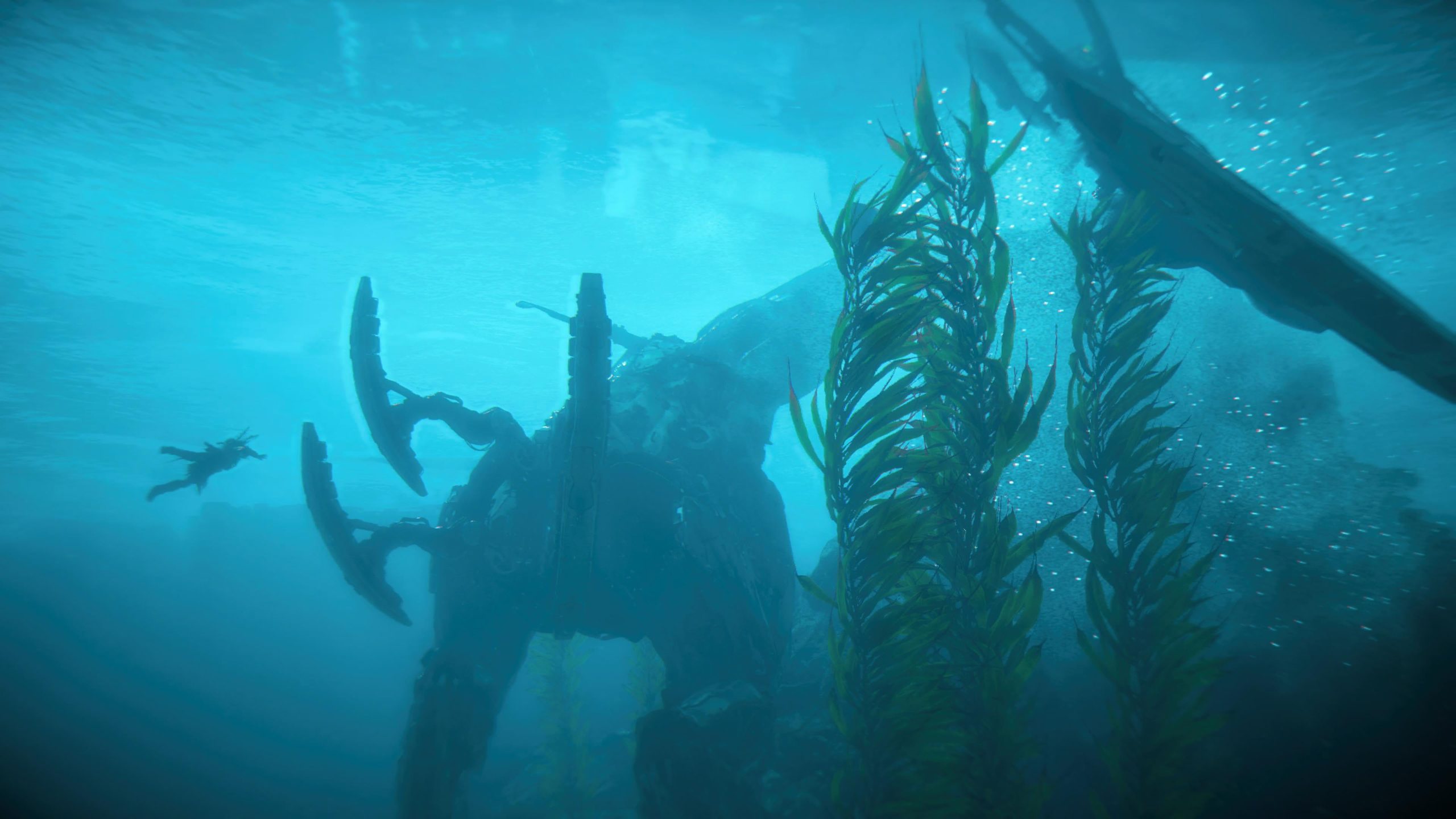
After 50-odd hours, I’ve hit the credits with dozens of optional activities left unfinished, and I fully plan on checking out as many as I can in the coming weeks.
These side-quests are enriched by Forbidden West’s stellar acting and frighteningly realistic facial capture tech. In a lovely touch, one I don’t think I’ve ever seen so aptly captured in a video game, characters don’t always maintain eye contact, often breaking it in the middle of conversation, looking off into the distance or down at their feet. Eye contact is hard! Real people don’t maintain it for every second of every conversation; we’re not BioWare dialogue trees.
Horizon Forbidden West neatly organizes its library of secondary activities with a near foolproof set of submenus. Side-quests officially marked as side-quests are the meaty ones, the ones with fascinating narrative or mechanical twists. Errands, meanwhile, consist of the one-act stuff — standard fare like hunts and fetch quests. But even some errands offer up unique scenarios. (One notable errand had me quietly tail a robot triceratops and pluck flowers out of its, um, waste without getting noticed.) There are further categories for everything else, from combat challenges to platforming gauntlets to environmental puzzles tucked away in the world’s dustiest corners. By categorization alone, you can instantly tell the degree of depth you’ll find and commitment you’ll need for each activity, a design choice that more developers of open-world games should copy.
But behind every small convenience hides a slightly less-small inconvenience, showing how the Horizon series — yeah, it’s a series now — has failed to keep pace with advancements made by open-world game design over the past half a decade.
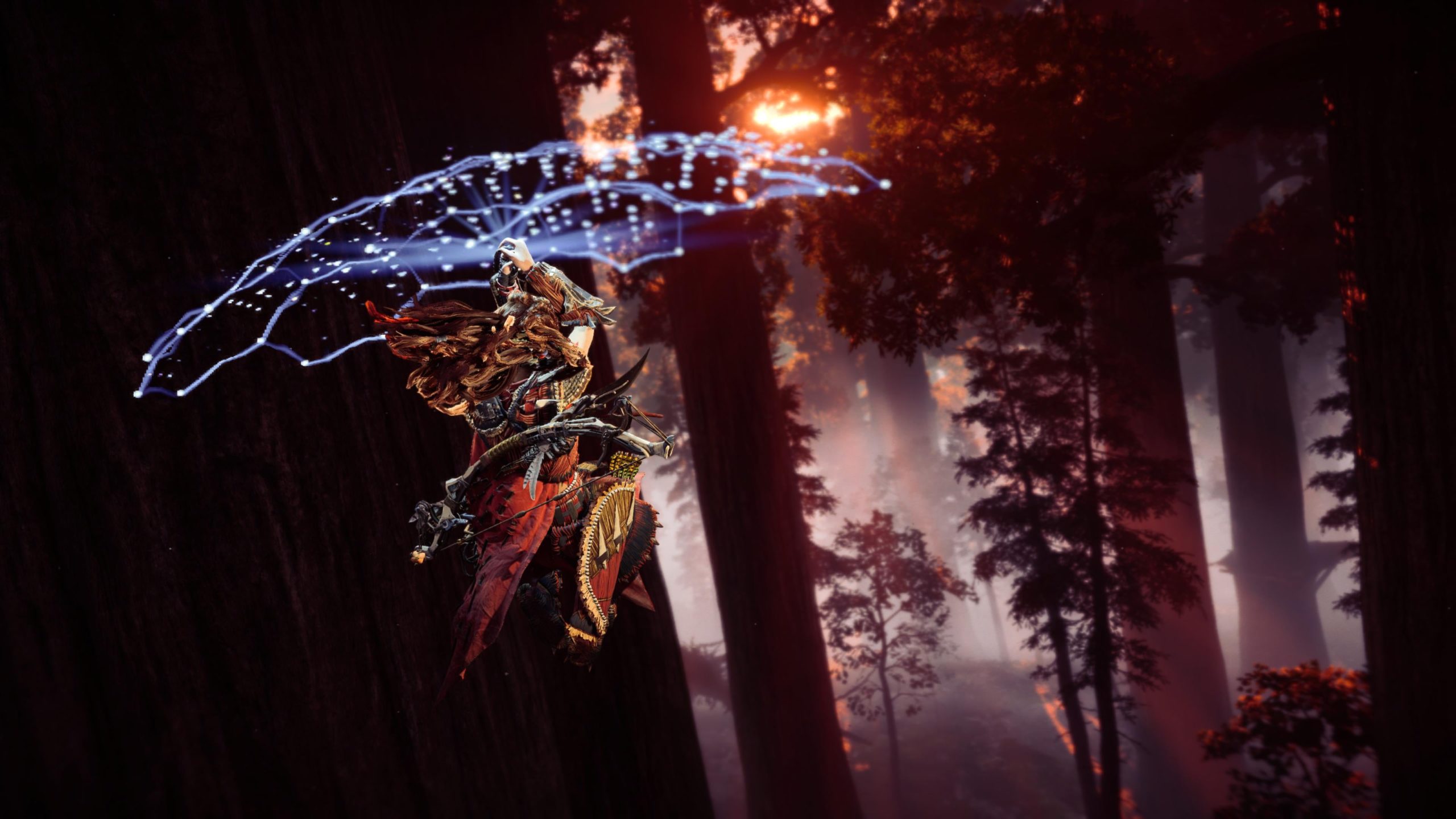
After you commandeer a dino-robot for use as a mount, you can call it to your side at any moment, but you can’t bring it into any settlements — a minor annoyance made particularly conspicuous when you visit a settlement arranged along a very narrow mountain pass. You leave your mount at one end, then call it to you again…a whole two seconds later. How’d you get here, buddy?
When allies fall in battle, you can revive them, or they’ll automatically revive after about 30 seconds or so. Great! But when it comes time to follow those allies for a quest, you’ll have to slow down to match their speed. Less great…
If you approach an environmental puzzle you can’t yet solve due to lacking a piece of gear, Aloy will openly remark how she doesn’t seem to have the necessary equipment, saving you from wasting time learning that yourself the hard way. Actually, hmm, no drawback to that one — it’s simply fantastic.
There are dozens if not hundreds of fast-travel points, designated as campfires. The catch? You can only initiate travel when you’re at one of those campfires, unless you want to burn hard-earned shards (Horizon’s in-game currency).
The autosave is forgiving, but if you want to manually save (c’mon, who here has full trust in the autosave?), you can only do it at one of these campfires.
Then there’s the stash, one of Forbidden West’s most singularly accommodating features. When you loot a resource your pack is already full of, it’ll automatically go into your stash, which shows up at any of the game’s bazillion outposts and, in my experience, has limitless space. But while you’re exploring, you still have to stop in your tracks to pick stuff up; you can’t snag some flowers while sprinting through a field, à la Ghost of Tsushima.
It’s a bummer that Horizon Forbidden West doesn’t make looting as seamless as possible, because the game is designed to have you loot everything. While exploring, you’ll nab ridgewood, fiberzest, vigorstem, bitter leaf, sourflame, medicinal berries, and crunchy spikestalks from a sea of vegetation. Off the metal skeletons of machines, you’ll get tusks, nerves, cores, coils, blaze, sparkers, circulators, stickpaste, blastpaste, glowblast, chillwater, purgewater, metalbite, crystal braiding, volatile sludge, machine hearts, machine muscle, machine minds. In chests and sunken caches, you’ll find relics from the old world, sellable trinkets like chimes (car keys) or jewellery (a smartwatch). All of those are real items from the game, by the way, save for one I totally made up. (See if you can’t guess.)
These are essential not just for crafting various traps and tools but also for participating in Horizon Forbidden West’s economy. Want to buy a “pulverizing spike thrower”? Well, you’ll need 1,062 shards, a sunwing circulator, and a large machine core. Want to upgrade its efficacy? OK, now you need 127 shards, four braided wires, four small machine cores, and one medium machine core. For the next level, and for the one after that, you’ll need a wholly different set of loot. These requirements are distinct for every piece of gear in the game.
That’s not all. If you want to increase your carrying capacity, you’ll have to hunt non-machine creatures — actual animals — for hides, bones, feathers, and such, an act that gets real old, real fast. I’m not just saying this because the whimper a fox makes when it dies sounds a lot like the noise my cat makes when he’s hungry. (OK, I’m kinda saying this because the whimper a fox makes when it dies sounds a lot like the noise my cat makes when he’s hungry.) It all feels like a tedious vestige from a prior era of gaming. Just let me spend my shards on a bigger quiver!
All of your gear — whether it’s a long-range “sharpshot” bow or a snazzy armour set with perks that fit your playstyle — has a distinct array of stats, correlating positive or negative defence ratings for a litany of elemental damage types. You can tweak your equipment with “coils,” or augmentations, applying minor stat bonuses. Every enemy, too, is resistant to certain elements and weak to others, info you can pick up by highlighting them with Aloy’s Focus device.
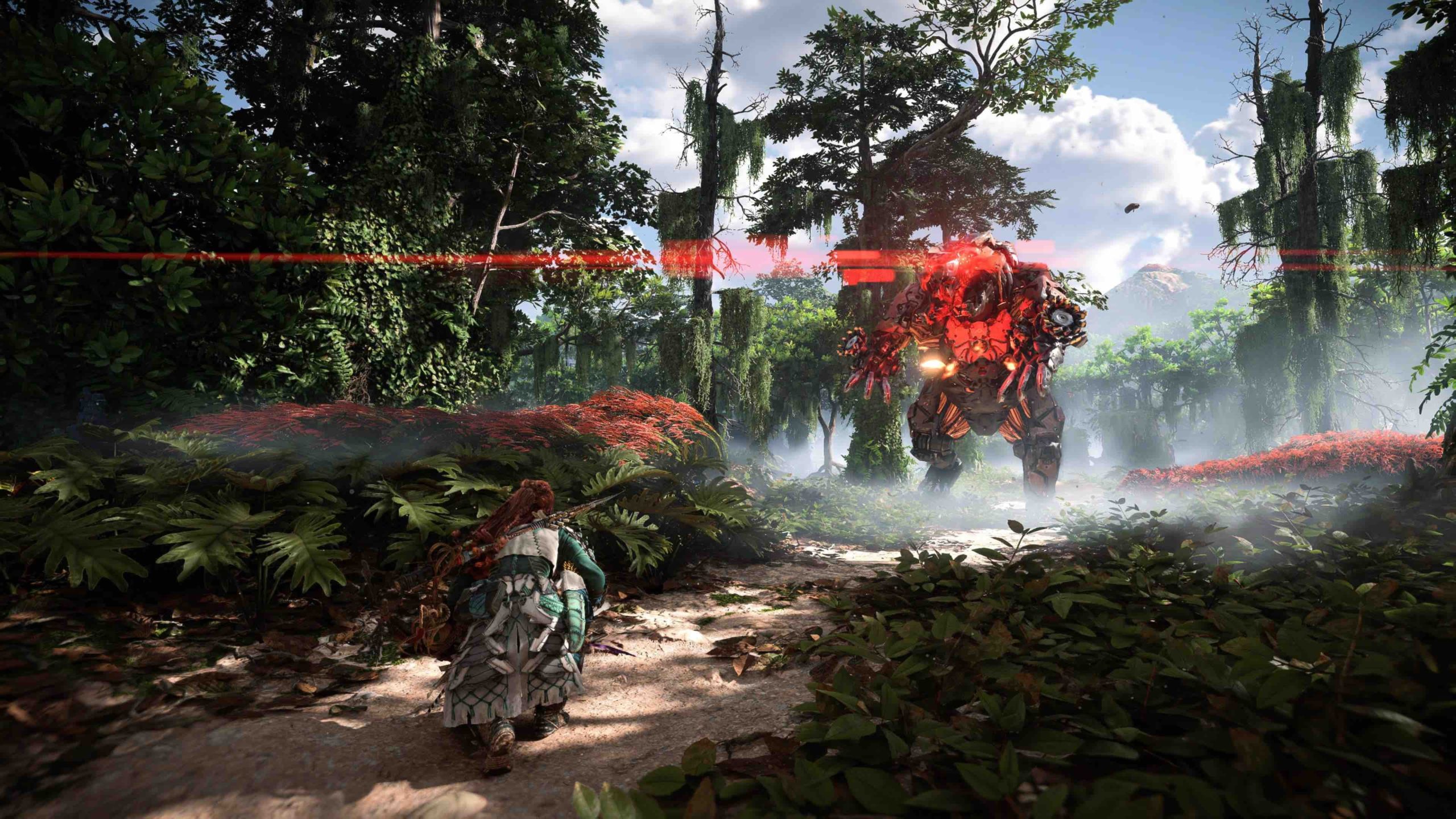
Zero Dawn set itself apart from its contemporaries by encouraging a thoughtful, tactical approach to combat, something that remains present in Forbidden West. You might be several levels over par, you might be playing on the standard difficulty tier, and you could still get stomped by a robot velociraptor if you’re not careful. Battles play out smoothest if you hammer out a plan of attack beforehand — marking enemy walking routes and laying traps and crafting the most effective ammo — so it behooves you to quietly assess combat scenarios from the sidelines and tailor your loadouts before jumping into the fray. But we all know how plans go, and sometimes you need to quickly break out the big bows. Whatever the case, your odds are best if you have a wide array of fully leveled-up equipment.
I’m sure some people will salivate over all this potential fine-tuning; that sound you hear is the dulcet chorus of a thousand Google Sheets being opened and primed around the world. Me? I unlocked a skill that essentially turned one of Aloy’s bows into a rocket launcher and stopped obsessing about that stuff. If I had the loot necessary to complete an upgrade or buy a snazzy set of armour, cool! If not, well, so be it. I had rockets.
Nothing in Horizon Forbidden West sunk its claws in me more than a mini-game. I’m not sure when exactly this trend truly took off — I blame The Witcher 3’s “Gwent” — but every expansive open-world RPG these days apparently has to feature an in-universe board game of some sort. Horizon Forbidden West’s take is a turn-based tactics game called “Machine Strike.”
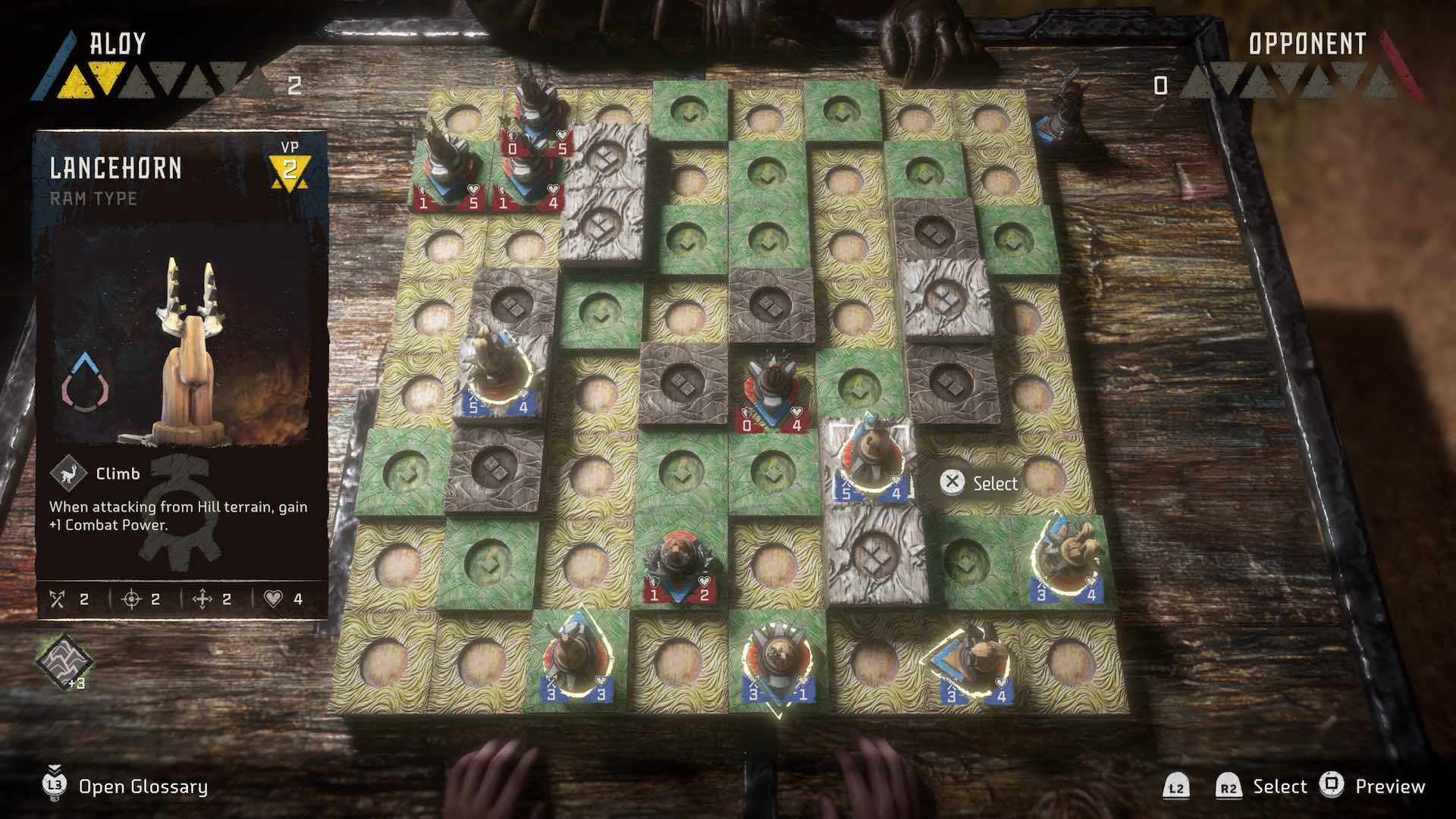
Matches of “Machine Strike” play out on a square grid-based board. You and an opponent each have a set number of pieces, all based on the machines you fight against in the “real” game. Your goal isn’t to wipe out all of your opponent’s pieces. See, every piece is allotted a number of points. Taking an opponent’s piece out will award you that many points; similarly, if you lose a piece, your opponent will earn however many points it was worth. Your goal is to hit seven points before your opponent does.
You’re given 10 points to customise a set of pieces. Stronger pieces, which have higher attack and HP values, are typically worth more points. So it becomes a measure of risk-versus-reward. Do you stack your set with low-value, low-power pieces? Or do you choose just a couple of strong ones?
The board itself is a strategic landmine. Tiles can appear as one of six terrain types, which alter a piece’s stats, sometimes providing bonus effects or debuffs. Plus, every piece — just like the machines they’re based on — has strengths and weaknesses. Attack one from the side and you may deal extra damage. Attack another from the same vantage, however, and you might hit armoured sides, nullifying some of your damage.
I cannot possibly emphasise this enough: “Machine Strike” on its lonesome might already be my favourite game of the year. (I’m a huge sucker for good tactics.) Were I not on a tight deadline to complete Horizon Forbidden West, I’d have sought out every single “Machine Strike” player.
Oh, yes, “Machine Strike” isn’t just something you access via menus. Most towns, cities, and settlements are home to an NPC who plays the game. Defeat them on three boards and they’ll award you with a piece, which you can use to further customise your sets, helping you defeat tougher players in other towns. One afternoon, I found myself wholly ignoring my more pressing quest log and, instead, charted a course from Plainsong to Scalding Spear through Fall’s Edge and Thornmarsh — yes, the city names are amazing — just to seek out more “Machine Strike” players.
It’s one small touch that makes Horizon Forbidden West’s settlements more than mere pit stops for resupplying. These cities aren’t real places, but sometimes feel like they are. Despite playing a major role in the game’s marketing, San Francisco plays a disappointingly minor role in Forbidden West’s overarching story, not even showing up (for me at least) until the 25-hour mark. Instead, you spend much of your time bouncing between truly visionary locales: a bustling post-apocalyptic metropolis built around a crashed cargo plane in the Nevada desert; a driftwood citadel on a whitesand beach near– according to my admittedly amateur geolocating–modern-day Alameda. It’s fantastical digital tourism at its finest.
That’s what you want from an open-world game, right? Not necessarily an airtight main plot, as nice as such a thing is, but a believable, well-realised world you can lose yourself in. In that regard, Horizon Forbidden West hits it out of the park.
A side-quest in Horizon Forbidden West’s opening area introduces you to an elderly man. He’s sitting on a ledge high in the mountains, staring at a giant robot pterodactyl embedded in a rocky spire, well and truly dead. He’s convinced that its death was an act of the gods, that observing it will grant him salvation, and so he plans on sitting and staring and waiting until he’s shown the heavenly lit way to a new home where everything is safe. Aloy points out how, actually, the bird-robot was gunned down by heavy artillery. He doesn’t listen. He’s convinced it’s a sign.
Setting aside the high-minded sci-fi hijinks, Horizon Forbidden West is at its core about the extent to which characters will go to find faith and meaning. In her newfound “saviour” status — again, still weird — Aloy finds herself fielding many of these evidence-free assertions. People go on and on about “land gods” and “diviners” and “legacies” and blah blah blah. At every turn, Aloy reacts to these whims with curled-lip bemusement. They claim to see god. Aloy knows the truth; she literally sees it.
By the end of the game, I found myself reacting to Horizon Forbidden West itself with a similar curled-lip bemusement.
[review heading=”Horizon Forbidden West” image=”https://www.kotaku.com.au/wp-content/uploads/sites/3/2022/02/14/9873b9b8540bb3e6ab077a600b72cdfe.jpg” label1=”Back-of-the-box quote” description1=””No BotW to distract you this time!” – Kotaku.com” label2=”Type of game” description2=”Sci-fi twist on the Museum of Natural History’s dino hall” label3=”Liked” description3=”Fluid combat, sharp dialogue, a rewarding open world, constantly getting distracted by how damn pretty everything is.” label4=”Disliked” description4=”Instances of tone-deafness, minor inconveniences due to outdated design, a story that goes off the rails” label5=”Developer” description5=”Guerrilla Games” label6=”Platforms” description6=”PS4, PS5 (played)” label7=”Release date” description7=”February 18, 2022″ label8=”Played” description8=”Roughly 50 hours to hit the credits with roughly 50 per cent completion” ]
Horizon Zero Dawn succeeded for many, many reasons, though perhaps its strongest feature was the way it expertly conveyed a dual-timeline narrative split between past (how the earth succumbed to robot apocalypse) and present (how the earth’s current inhabitants want to prevent another one). You made as much of the tale as you wanted to. Audio logs and text messages filled in the backstory of how exactly the world dovetailed into shit. You could opt into these as much or as little as you chose, but even if you availed yourself of every one, you’d still not know everything, not really. You filled in the gaps yourself.
Audio logs and text messages are still present (by the hundreds) in the sequel, but Horizon Forbidden West goes out of its way to explicitly address questions — not just those posed in this game but those lingering from the first one too. Horizon is at its most intriguing when you’re slowly unspooling the thread. The magic trick doesn’t quite land when you’re having everything imparted to you via lecture and exposition. You and I will never know every little thing about the real world we live in — about its people, about its history. Why do we need to know so much about this fake one? Where’s the room for some imagination?
It’s not solely a problem with Horizon Forbidden West, nor is it a problem limited to video games. You see it across popular genre fiction these days, as everything from Star Wars to the Marvel Cinematic Universe doubles down on plot over people, going so far as to fill in backstories for enigmatic characters who were killed off years ago. Everyone does it these days. It’s the safe play. Welcome to the Era of Fandom.
I thoroughly enjoyed Horizon Forbidden West, and I suspect anyone who loves open-world RPGs will thoroughly enjoy it as well. But despite getting a kick out of fighting robot dinos, despite the enthralling time sink of “Machine Strike,” despite finding myself ravenous to return to this rich, inspired open world, I can’t shake how plainly Forbidden West misses the one philosophical throughline that helped its predecessor ascend to greatness: Sometimes, the question is more interesting than the answer.
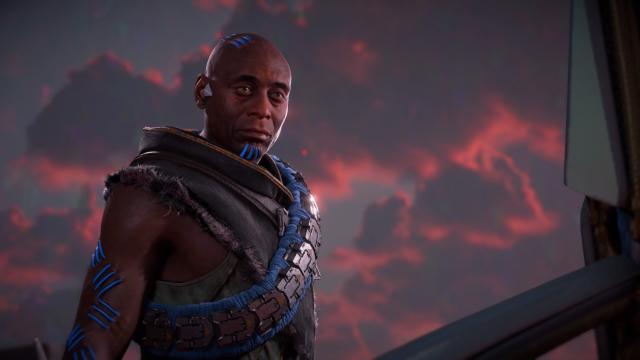
Leave a Reply